Following the Ramstein meeting that was held on January 20, 2022, the United States committed to supplying Ukraine with 31 M1A1 Abrams to boost the armor capabilities of the Ukrainian army against Russian forces. The M1A1 Abrams was initially developed for the U.S. military in the 1980s to counter the threat of Soviet-era T-72s.
Follow Army Recognition on Google News at this link
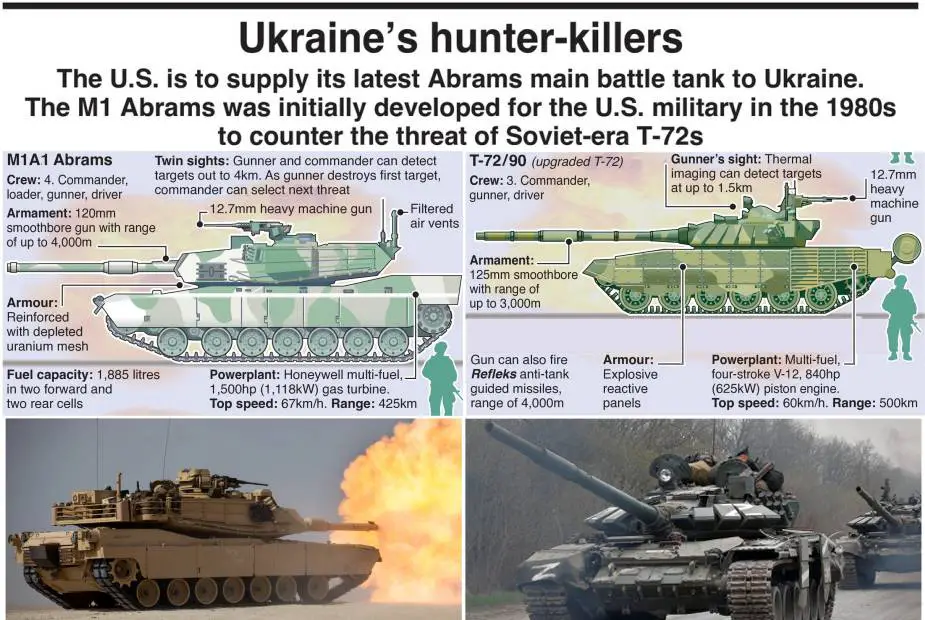
Analyzing US M1A1 Abrams vs. Russian T-72 Series Tanks in Modern Combat. (Picture source Graphic News / Army Recognition)
During the 1991 Gulf War, US-led coalition forces encountered Iraqi T-72 tanks, some of which were variants derived from the Soviet design. The M1A1 Abrams, which was used by US forces, demonstrated its superiority in these engagements, with its advanced fire control systems and superior armor proving decisive. The T-72s often had difficulty penetrating the M1A1's advanced armor, and their lower-quality fire control systems made it harder for them to hit targets effectively.
The M1A1 Abrams and the Soviet T-72 are both main battle tanks (MBTs) developed during the Cold War by the United States and the Soviet Union, respectively. While these tanks have never engaged in a direct battle between them, they have seen combat in various conflicts involving countries that use or have used these tanks.
The M1A1 Abrams, developed in the early 1980s, is an upgrade of the original M1 Abrams tank. It features a more powerful 120mm smoothbore cannon, improved armor, and advanced fire control systems. The M1A1 Abrams is known for its speed, agility, and accuracy, as well as its ability to withstand hits thanks to its advanced armor.
On the other hand, the Soviet T-72 was introduced in the early 1970s and quickly became one of the most widely produced and exported tanks in the world. The T-72 is known for its low profile, high mobility, and relatively low cost, making it a popular choice for many countries. However, the T-72's armor and fire control systems were less advanced compared to the M1A1 Abrams, making it more vulnerable to enemy fire.
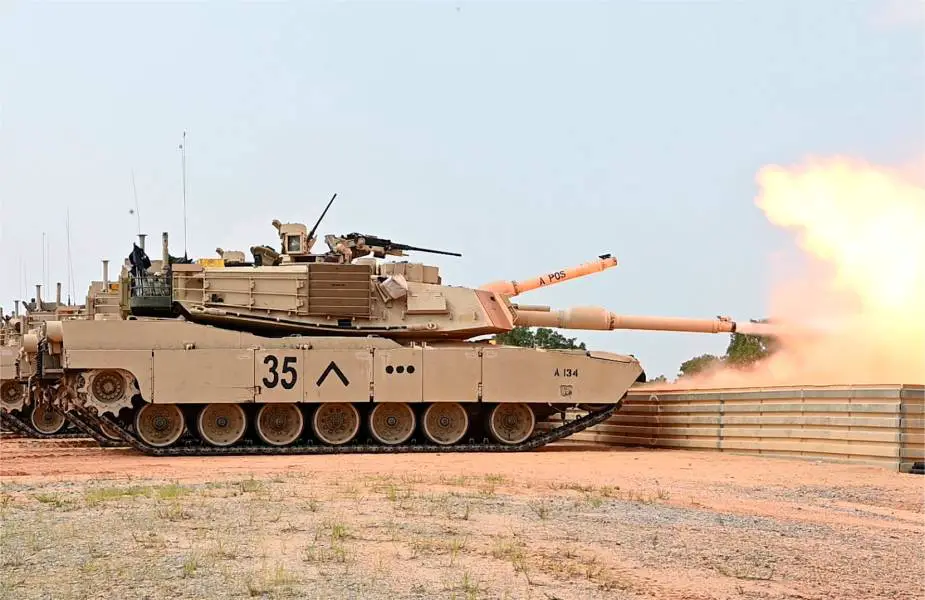
U.S. Army National Guard Soldiers with Company A, 4th Battalion, 118th Infantry Regiment, South Carolina National Guard, out of Dillon, South Carolina, conduct live-fire accuracy screening tests on M1A1 Abrams tanks, July 22, 2021, at Fort Jackson in Columbia, South Carolina. (Picture source U.S. DoD)
The M1A1 Abrams holds a distinct edge over the T-72 family of tanks in various aspects, making it a more formidable opponent on the battlefield. One key advantage lies in its advanced composite armor known as Chobham armor, which offers superior protection against anti-tank munitions compared to the less advanced steel and composite armor found on the T-72. Moreover, the M1A1 Abrams can be outfitted with reactive armor or active protection systems for further protection, while the T-72 has more limited options for armor upgrades.
In terms of firepower, the M1A1 Abrams is equipped with a 120mm smoothbore gun that delivers greater accuracy and penetration capabilities compared to the 125mm smoothbore gun on the T-72. The advanced fire control system on the M1A1 enables quicker target acquisition and an improved first-round hit probability. Additionally, the M1A1's selection of advanced sabot and HEAT rounds provides superior penetration and damage potential.
The M1A1 Abrams can also fire depleted uranium (DU) rounds. Depleted uranium is a byproduct of the uranium enrichment process and is denser than traditional materials used in armor-piercing projectiles. The most common type of depleted uranium round used by the M1A1 Abrams is the M829 series of armor-piercing, fin-stabilized, discarding sabot (APFSDS) rounds.
These DU rounds are designed to penetrate heavily armored targets, such as main battle tanks, by using their high mass and velocity to punch through armor. Upon impact, the depleted uranium penetrator deforms and self-sharpens, increasing its ability to penetrate the target. Additionally, the depleted uranium ignites upon impact, causing secondary damage inside the target due to the incendiary effect.
The engagement range of the M1A1 Abrams using its 120mm ammunition varies depending on the type of round and the target. Armor-Piercing Fin-Stabilized Discarding Sabot (APFSDS) rounds, such as the M829 series, are designed for penetrating heavily armored targets and have an effective range of approximately 2,000 to 3,000 meters, although they can reach targets beyond 4,000 meters under favorable conditions.
While both tanks have similar top speeds, the M1A1 Abrams boasts a more powerful gas turbine engine, which results in better acceleration and maneuverability. The suspension system on the M1A1 is also better suited to handling rough terrain, offering a smoother ride and a more stable firing platform. The M1A1 Abrams can reach a top forward speed of around 67 km/h (42 mph) on roads and approximately 40-48 km/h (25-30 mph) off-road. Its reverse speed is about 40 km/h (25 mph). The T-72 series tanks can reach a top forward speed of around 60-70 km/h (37-43 mph) on roads, and approximately 40-48 km/h (25-30 mph) off-road. The reverse speed of the T-72 series tanks is about 15-24 km/h (9-15 mph), depending on the specific variant.
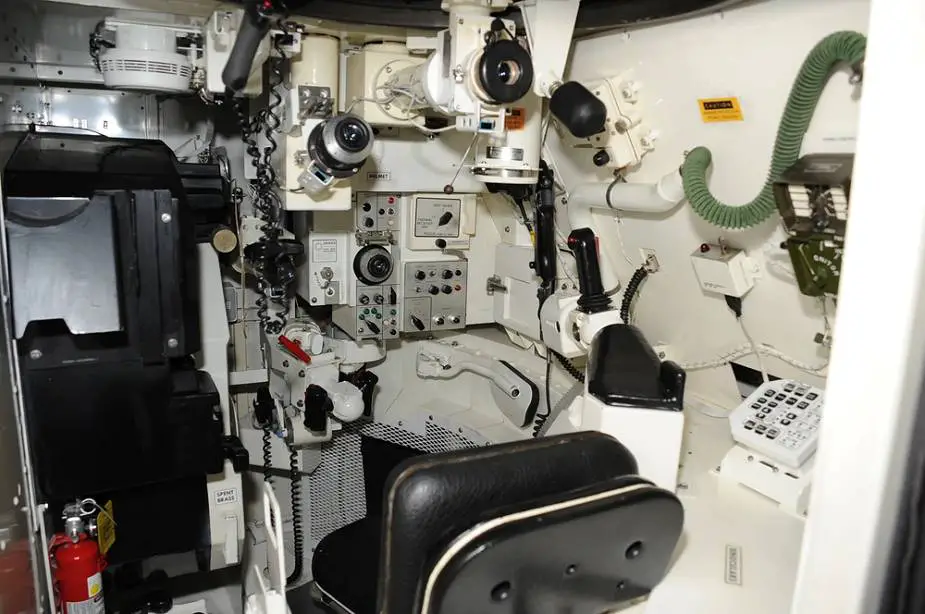
Inside view of M1A1 Abrams tank. (Picture source U.S. DoD)
The M1A1 Abrams benefits from improved optics, thermal imaging, and night vision capabilities, which allow its crew to detect and engage targets more effectively in a range of lighting and environmental conditions. In contrast, the T-72's optics and night vision systems are generally considered inferior.
Crew comfort and protection are also enhanced in the M1A1 Abrams, with a larger crew compartment providing more space and comfort, leading to better performance in combat. The ammunition storage system in the M1A1 is designed with blowout panels, reducing the risk of a catastrophic ammunition explosion if the tank is penetrated.
Finally, the M1A1 Abrams possesses a more sophisticated communication and networking system, which facilitates better coordination and integration with other friendly units, providing a significant tactical advantage on the battlefield.
In conclusion, when comparing the M1A1 Abrams and the T-72 series, the M1A1 Abrams is generally considered to have superior armor, firepower, and situational awareness, giving it a significant advantage in most combat scenarios. However, the T-72 series, particularly modernized versions like the T-72B3, has seen numerous upgrades that enhance its capabilities.
While the M1A1 Abrams has the edge in many technical and tactical aspects, the outcome of engagements between these two tanks can be influenced by factors such as crew training, tactical situation, specific tank variants, and the types of ammunition used.
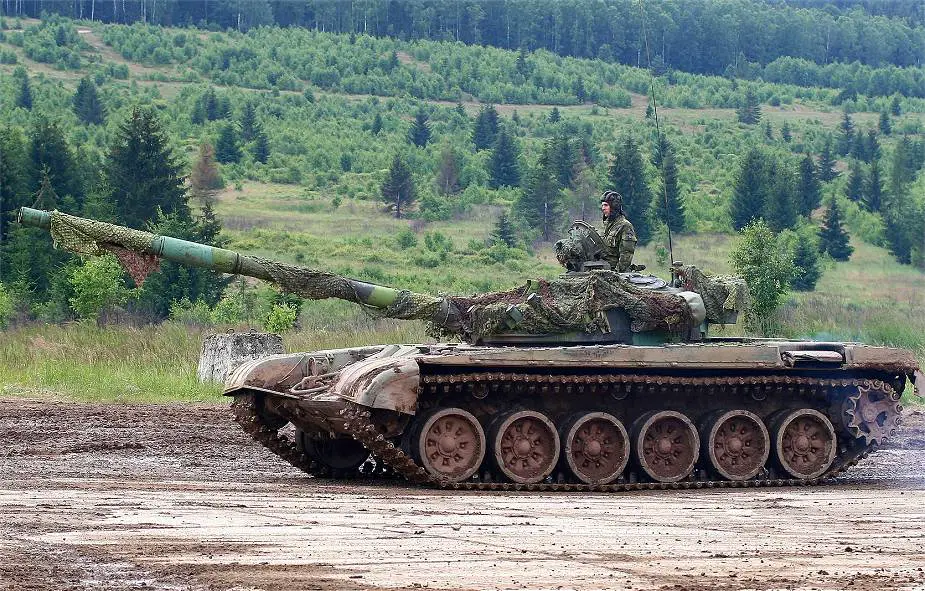
One of the common tanks in the T-72 series is the T-72M1. (Picture source Wikimedia)
Although the M1A1 Abrams is widely regarded as a more advanced tank in numerous aspects, the T-72 series does possess a few tactical and technical advantages. One such advantage is the T-72's lower profile, which renders it a smaller target and more challenging to detect on the battlefield. In certain situations, this offers a tactical advantage, as enemy forces may find it harder to spot and engage the T-72.
Another advantage of the T-72 series is its diesel engine, which is more common and easier to source compared to the gas turbine engine found in the M1A1 Abrams. This aspect simplifies logistics and maintenance for countries that operate the T-72.
Additionally, the T-72 series is equipped with an autoloader system, which automatically loads the main gun. This feature reduces the crew size to three members, as opposed to the M1A1 Abrams' four-member crew. Although the autoloader can be slower and less reliable than a human loader, it decreases the number of required crew members and potentially creates more space within the tank.
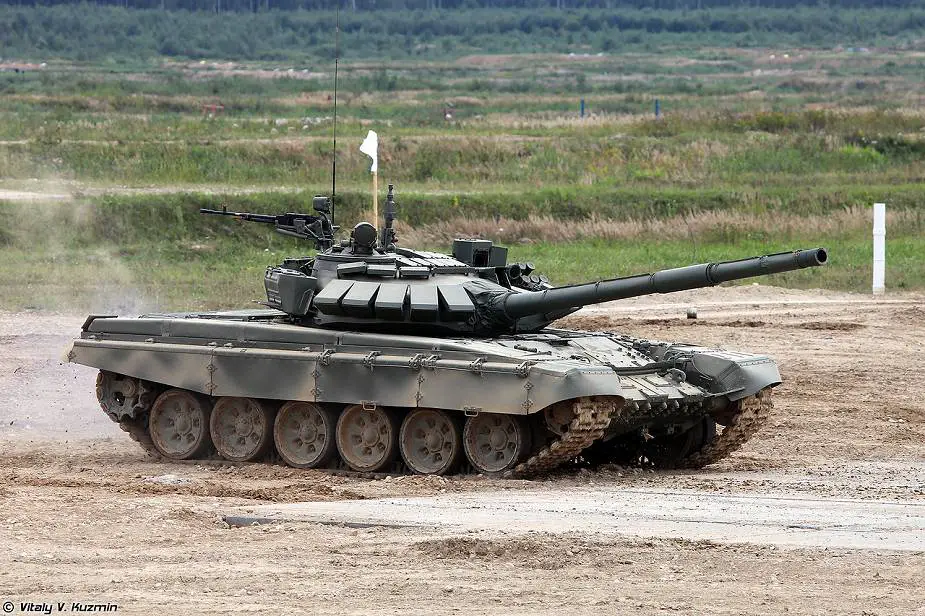
The T-72B3 is the most popular Main Battle Tank used by the Russian army in Ukraine. (Picture source Vitaly Kuzmin)
In the war in Ukraine, the most deployed tank by the Russian forces is the T-72B3. It is a modernized version of the Soviet-era T-72 main battle tank, featuring several improvements in firepower, armor, and mobility compared to earlier models.
The T-72B3 is equipped with an upgraded 125mm 2A46M-5 smoothbore gun, which is capable of firing a variety of ammunition types, including armor-piercing fin-stabilized discarding sabot (APFSDS), high-explosive anti-tank (HEAT), and high-explosive fragmentation (HE-FRAG) rounds. While this gun provides substantial firepower, it is generally considered to have less accuracy and penetration capabilities than the 120mm smoothbore gun of the M1A1 Abrams.
The firing range of the T-72 series using its 125mm ammunition depends on the type of round and the target being engaged. Armor-Piercing Fin-Stabilized Discarding Sabot (APFSDS) rounds, such as the 3BM-series, are designed for penetrating heavily armored targets and have an effective range of approximately 2,000 to 3,000 meters
The T-72B3 can also fire modern 3BM-series APFSDS rounds with improved penetration, as well as 9M119 Refleks (AT-11 Sniper) anti-tank guided missiles (ATGMs) that can be fired from the main gun. The ATGMs offer the T-72B3 an extended engagement range (up to 5,000 meters) and the ability to engage heavily armored targets. The T-72B3 has an improved fire control system compared to older T-72 models, including an upgraded ballistic computer, thermal imaging, and a laser rangefinder.
The T-72 series, especially modernized versions like the T-72B3, can be equipped with various types of ERA, such as Kontakt-5 or Relikt ERA. These advanced ERA systems provide better protection against modern anti-tank munitions than earlier ERA types, but they still have limitations when facing state-of-the-art APFSDS rounds. The ERA armor on T-72 series tanks can provide an additional layer of protection against certain types of anti-tank munitions, but it is less effective against the modern APFSDS rounds used by tanks like the M1A1 Abrams.















